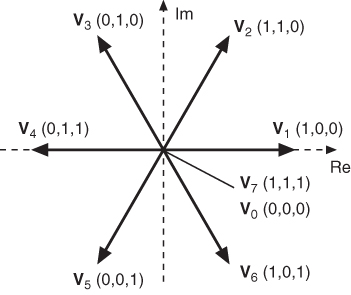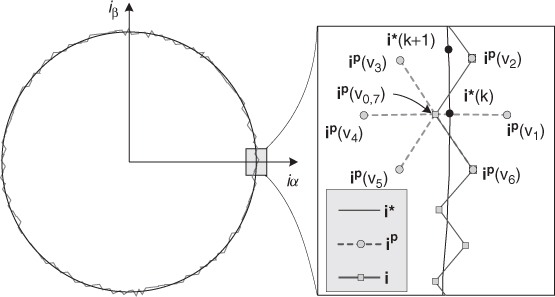4.7 Working Principle
In order to illustrate how the predictive control strategy works, a detailed example is shown in Figure 4.5 and Figure 4.6. Here, load currents iα, iβ, and their references are shown for a complete period of the reference. Using the measurement i(k) and all switching states of the voltage vector v(k), the future currents i(k + 1) are estimated, ip(k + 1).
Figure 4.4 Voltage vectors in the complex plane

Figure 4.5 Working principle: vectorial plot of the reference and predicted currents

In the vectorial plot, shown in Figure 4.5, it can be observed that vector V2 takes the predicted current vector closest to the reference vector.
As shown in Figure 4.6, current ![]() corresponds to the predicted current if the voltage vector V0 or V7 is applied at time k. It can be seen in this figure that vectors V2 and V6 are the ones that minimize the error in the iα current, and vectors V2 and V3 are the ones that minimize the error in the iβ current, so the voltage vector that minimizes the cost function g is V2.
corresponds to the predicted current if the voltage vector V0 or V7 is applied at time k. It can be seen in this figure that vectors V2 and V6 are the ones that minimize the error in the iα current, and vectors V2 and V3 are the ones that minimize the error in the iβ current, so the voltage vector that minimizes the cost function g is V2.
These figures illustrate the meaning of the cost function as a measure of error or distance between reference and predicted vectors. It is easy to view these errors ...
Get Predictive Control of Power Converters and Electrical Drives now with the O’Reilly learning platform.
O’Reilly members experience books, live events, courses curated by job role, and more from O’Reilly and nearly 200 top publishers.

